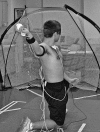Recovery of upper extremity sensorimotor system acuity in baseball athletes after a throwing-fatigue protocol
- PMID: 18174932
- PMCID: PMC2140069
Recovery of upper extremity sensorimotor system acuity in baseball athletes after a throwing-fatigue protocol
Abstract
Context: Research indicates that upper extremity fatigue hampers sensorimotor system acuity. However, no investigators have observed recovery of upper extremity acuity after fatigue.
Objective: To observe recovery of active position reproduction acuity in overhead throwers after a throwing-fatigue protocol.
Design: Single-session, repeated-measures design.
Setting: University musculoskeletal laboratory.
Patients or other participants: Sixteen healthy collegiate baseball players (age = 21.0 +/- 1.6 years, height = 175.8 +/- 10.2 cm, mass = 82.8 +/- 4.3 kg).
Intervention(s): Subjects threw a baseball with maximum velocity (every 5 seconds) from a single knee. Every 20 throws, subjects rated their upper extremity exertion on a Borg scale until reporting a level of more than 14.
Main outcome measure(s): We used an electromagnetic tracking system to measure active multijoint position reproduction acuity at 5 intervals: prefatigue; immediately postfatigue; and after 4, 7, and 10 minutes of recovery. Blindfolded subjects reproduced their arm-cocked and ball-release positions. Dependent variables were 3-dimensional variable errors of scapulothoracic, glenohumeral, elbow, and wrist joints; endpoint (ie, hand) position error represented overall upper extremity acuity. The independent variable was time (measured prefatigue and at 4 postfatigue intervals).
Results: Fatigue significantly affected acuity of scapulothoracic, glenohumeral, and elbow joints and endpoint error for both positions (P < .001). Fatigue significantly affected wrist acuity only for ball release (P < .001). For arm-cocked reproduction, each measure of acuity, except that of the glenohumeral joint, recovered by 7 minutes; for ball release, each measure of acuity recovered within 4 minutes (P > .05).
Conclusions: The sensorimotor system deficits that we observed after fatigue recovered within 7 minutes in most upper extremity joints. Glenohumeral arm-cocked position reproduction acuity failed to recover within 10 minutes. Research indicates that overhead throwers are vulnerable in this position to the capsulolabral injuries commonly observed in throwing athletes. Future researchers should explore this relationship and the effectiveness of exercises aimed at enhancing sensorimotor system acuity and endurance.
Keywords: joint position sense; multijoint position reproduction.
Figures





Similar articles
-
Effect of Fatigue Protocols on Upper Extremity Neuromuscular Function and Implications for Ulnar Collateral Ligament Injury Prevention.Orthop J Sports Med. 2019 Dec 26;7(12):2325967119888876. doi: 10.1177/2325967119888876. eCollection 2019 Dec. Orthop J Sports Med. 2019. PMID: 31903400 Free PMC article. Review.
-
Functional fatigue and upper extremity sensorimotor system acuity in baseball athletes.J Athl Train. 2007 Jan-Mar;42(1):90-8. J Athl Train. 2007. PMID: 17597949 Free PMC article.
-
Functional multijoint position reproduction acuity in overhead-throwing athletes.J Athl Train. 2006 Apr-Jun;41(2):146-53. J Athl Train. 2006. PMID: 16791298 Free PMC article.
-
A comparison of individual joint contributions to multijoint position reproduction acuity in overhead-throwing athletes.Clin Biomech (Bristol). 2006 Jun;21(5):466-73. doi: 10.1016/j.clinbiomech.2005.12.015. Epub 2006 Feb 14. Clin Biomech (Bristol). 2006. PMID: 16481079 Clinical Trial.
-
Regional Interdependence and the Role of the Lower Body in Elbow Injury in Baseball Players: A Systematic Review.Am J Sports Med. 2020 Dec;48(14):3652-3660. doi: 10.1177/0363546520910138. Epub 2020 Apr 16. Am J Sports Med. 2020. PMID: 32298147
Cited by
-
More Elevated Fastballs Associated With Placement on the Injured List due to Shoulder Injury.Arthrosc Sports Med Rehabil. 2022 Feb 13;4(2):e623-e628. doi: 10.1016/j.asmr.2021.12.003. eCollection 2022 Apr. Arthrosc Sports Med Rehabil. 2022. PMID: 35494271 Free PMC article.
-
Current concepts in the evaluation and treatment of the shoulder in overhead-throwing athletes, part 1: physical characteristics and clinical examination.Sports Health. 2010 Jan;2(1):39-50. doi: 10.1177/1941738109338548. Sports Health. 2010. PMID: 23015922 Free PMC article.
-
Shoulder injuries in soccer goalkeepers: review and development of a FIFA 11+ shoulder injury prevention program.Open Access J Sports Med. 2016 Aug 8;7:75-80. doi: 10.2147/OAJSM.S97917. eCollection 2016. Open Access J Sports Med. 2016. PMID: 27563262 Free PMC article. Review.
-
Effect of Fatigue Protocols on Upper Extremity Neuromuscular Function and Implications for Ulnar Collateral Ligament Injury Prevention.Orthop J Sports Med. 2019 Dec 26;7(12):2325967119888876. doi: 10.1177/2325967119888876. eCollection 2019 Dec. Orthop J Sports Med. 2019. PMID: 31903400 Free PMC article. Review.
-
Recovery of pinch force sense after short-term fatigue.Sci Rep. 2023 Jun 9;13(1):9429. doi: 10.1038/s41598-023-36476-8. Sci Rep. 2023. PMID: 37296199 Free PMC article.
References
-
- Braatz JH, Gogia PP. The mechanics of pitching. J Orthop Sports Phys Ther. 1987;9:56–69. - PubMed
-
- Fleisig GS, Andrews JR, Dillman CJ, Escamilla RF. Kinetics of baseball pitching with implications about injury mechanisms. Am J Sports Med. 1995;23:233–239. - PubMed
-
- Pappas AM, Zawacki RM, Sullivan TJ. Biomechanics of baseball pitching: a preliminary report. Am J Sports Med. 1985;13:216–222. - PubMed
-
- MacWilliams BA, Choi T, Perezous MK, Chao EY, McFarland EG. Characteristic ground-reaction forces in baseball pitching. Am J Sports Med. 1998;26:66–71. - PubMed
-
- Lephart SM, Riemann BL, Fu FH. Proprioception and Neuromuscular Control in Joint Stability. Champaign, IL: Human Kinetics; 2000.
MeSH terms
LinkOut - more resources
Full Text Sources
Medical
